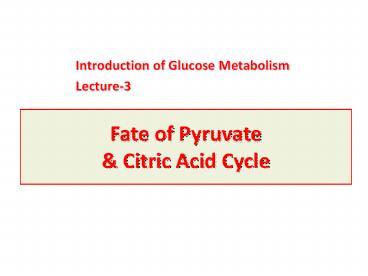Fate of Pyruvate - PowerPoint PPT Presentation
Title:
Fate of Pyruvate
Description:
Introduction of Glucose Metabolism Lecture-3 Fate of Pyruvate & Citric Acid Cycle Fate of pyruvate 1- Lactate (in cytosol) Enzyme: lactate dehyrogenase (LDH) in ... – PowerPoint PPT presentation
Number of Views:907
Avg rating:3.0/5.0
Title: Fate of Pyruvate
1
Fate of Pyruvate Citric Acid Cycle
- Introduction of Glucose Metabolism
- Lecture-3
2
Fate of pyruvate
- 1- Lactate (in cytosol)
- Enzyme lactate dehyrogenase (LDH)
- in anaerobic glycolysis
- 2- Acetyl CoA
- in mitochondria
- Enzyme pyruvate dehydrogenase
- occurs in aerobic glycolysis
- Acetyl CoA is required for citric acid
cycle (CAC) - 3- Oxalacetate
- in mitochondria
- Enzyme pyruvate carboxylase
- Oxalacetate is required for
- 1- Citric acid cycle (condenses with
acetyl CoA) to yield energy ATP - OR 2-Gluconeogenesis (to synthesize glucose)
3
Fate of Pyruvate
Glucose
glycolysis
Gluconeogenesis
No Oxygen No Mitochondria OR BOTH
mitochondria
PYRUVATE
LACTATE
OXALACETATE
Oxygen Mitochondria
ACETYL CoA
CITRIC ACID CYCLE
4
LACTATE DEHYDROGENASE
5
FATES OF PYRUVATE
6
OXIDATIVE DECARBOXYLATION OF PYRUVATE
Allosteric Regulation
7
Formation of acetyl CoA from pyruvate
- Pyruvate (end product of aerobic glycolysis) is
transported into the mitochondria. - In the mitochondrial matrix, pyruvate is
converted to acetyl CoA by - pyruvate dehydrogenase complex
(multienzyme complex) - This reaction is irreversible
- Pyruvate dehydrogenase complex is composed of
three enzymes five coenzymes - Coenzymes of the complex are derived from water
soluble vitamins - 1- Thiamine pyruphosphate, TPP (derived
from thiamine, vitamin B1) - 2- NAD (derived from niacin)
- 3- FAD (derived from riboflavin)
- 4- Lipoic acid
- 5- Coenzyme A (derived from pantothenic
acid)
8
Pyruvate dehydrogenase complex
PYRUVATE
ACETYL CoA
9
Citric acid cycle or,(Krebs cycle)
10
Citric Acid Cycle
- Citric acid cycle
- is the final pathway where the oxidative
metabolism of - Carbohydrates (as glucose), proteins (amino
acids) lipids (fatty acids) - to yield energy (ATP)
Acetyl CoA is the end product for oxidation of
carbohydrates, lipids proteins Acetyl CoA
condenses with oxalacetate to form citrate
(first reaction of the cycle) 3 NADH are
produced 3 X 3 9 ATP (by oxidative
phosphorylation) One FADH2 is produced 1 X 2
2 ATP (by oxidative phosphorylation) One ATP is
produced (by substrate level phosphorylation) Net
12 ATP / one acetyl CoA
11
Citric Acid Cycle CYCLE - SUMMARY
Acetyl CoA
3 NAD
3 NADH H
2 CO2
1 FAD
1 FADH2
1 ADP
1 ATP
12
(No Transcript)
13
KREBS CYCLE REACTIONS (1)
14
KREBS CYCLE REACTIONS (2)
Succinate Thiokinase
Substrate-Level Phosphorylation
15
KREBS CYCLE REACTIONS (3)
16
KREBS CYCLE ENERGY YIELD
17
Citric acid cycle or,(Krebs cycle)































